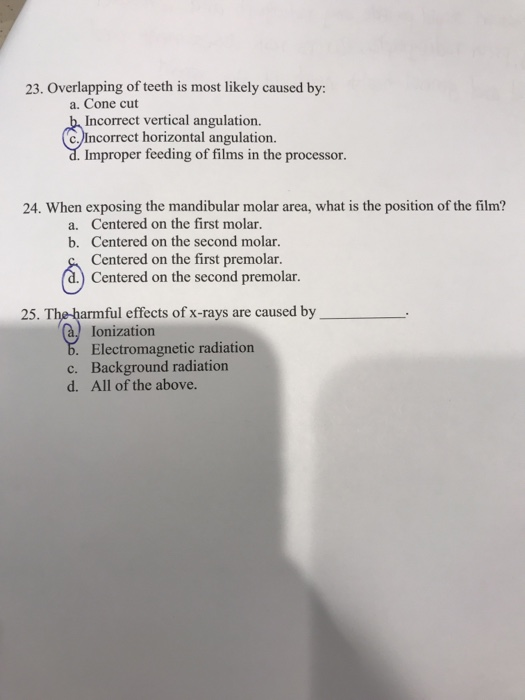Foreshortening is due an increased vertical angulation and elongation is due to a reduced vertical angulation RADIOGRAPHIC ERRORS AND ARTIFACTS ON THE FILM Stafne Gibilisco. Distorted images - from improper alignment of the tube object or film.

Exposure Technique Errors Ch 20 Flashcards Chegg Com
To correct an elongated image on an x-ray view the vertical angulation needs to be increased 42.

. Either elongated or foreshortened. In the slot of the film holder. Incorrect horizontal angulation results in overlapped unopened contact areas.
Foreshortening of images results from excessive vertical angulation. Improper Vertical angulation can cause elongation of the images or foreshortening of the films. When taking a full mouth series it is best to start with anterior images.
None of the above. Too little vertical angulation results in images that are. When this angulation is correct the vertical dimension of the tooth will be as realistic as possible.
A film with overlapped contact areas cannot be used to examine the interproximal areas of the teeth. The image of the teeth appears smaller than normal see figure 4-5. Chapter 23 Manson-Hing Chapter 3.
Incorrect vertical angulation can result in an image that is. The many inherent variables can inevitably result in image distortion and reproducible views are not possible with this technique17 An incorrect vertical tube head angulation will result in foreshortening or elongation of the image while an incorrect horizontal tube head angulation will cause overlapping of the crowns and roots of teeth7. The correct vertical angulation can usually be obtained by using the angles shown on the chart in figure 1-26.
Do all of the above. Notice the tube head is angled downward for maxillary radiographs and usually angled upward for mandibular radiographs. Slide the film sensor along the palate to minimize the possibility of eliciting the gag reflex.
Elongation is where the films appear longer than usual and foreshortening is where the films seem smaller or closer to the. Incorrect horizontal angulation of the PID results in. According to the guidelines for film placement the identification dot on the film is always placed.
Vertical angulation is the positioning of the x-ray cone in a vertical or up-and-down position 1. If the central ray of the x-ray beam is not centered on the film sensor a partial image will result in. Horizontal angulation is the side to side angulation 40.
What can occur from incorrect horizontal angulation. In adults a size ___. Vaginal foreshortening can occur after hysterectomy leading to inability to engage successfully in vaginal intercourse resulting in decreased quality of life.
What is the result of incorrect horizontal angulation. Vertical Angulation is the angle in the vertical plane at which the central x-ray beam is angled during dental radiographs. Elongation errors occur when the x-ray cone is under-angulated or too shallow causing the radiographic image to appear long and distorted.
Incorrect vertical angulation can result in an image that is. Which of the following errors can occur with the bite-wing. Incorrect vertical angulation errors can cause either elongation or foreshortening.
Incorrect horizontal angulation results in images that are. In this study we used three vertical angles 0 -10 10. Incorrect horizontal angulation of the PID results in.
Either elongated or foreshortened. Incorrect vertical angulation can result in an image that is. Incorrect horizontal angulation of the PID results in.
An incorrect vertical tube head angulation will result in foreshortening or elongation of the image while an incorrect horizontal tube head angulation will cause overlapping of the crowns and roots of teeth. Incorrect horizontal angulation results in overlapped unopened contact areas. The tube head may be horizontal 0 when X-raying mandibular molars.
The molar bitewing image should be centered over the. According to the guidelines for film placement the identification dot on the film is always placed. 1 Foreshortening exists if the vertical angulation is larger than necessary.
Results in a radiographic image that is not the same length as the tooth. Vertical angulation differs according to the technique being used it refers to the up and down plane it can be determined in degrees marked on the outside of the tubehead 41. One technique for the management of the patient with a gag reflex is to.
Incorrect vertical angulation may cause two problems--foreshortening or elongation. Elongation The distortion on a radiograph that results in lengthening of the image in one dimension. The vertical angle of bitewing radiography effects on estimating of alveolar bone loss.
What can result from an excessive vertical angulation. Proper film placemetn for bite-wing radiographs. The image appears either shorter or longer than the actual size foreshortened or elongated images Term.
Insufficient vertical angulation can result in an image that is. In the slot of the film holder. Vertical - elongation - vertical angulation too small.
The many inherent variables can inevitably result in image distortion and reproducible views are not possible with this technique. Incorrect vertical angulation errors can cause either elongation or foreshortening. Do all of the above.
None of the above. What horizontal angulation should be used for bitewing images. Position the film sensor slowly.
In maxilla by using zero vertical angle there was a little difference between real alveolar bone loss and radiographic measurement p-value0237In Mandible by using zero vertical angle. A wrong angulation results in a distorted.

Solved 23 Overlapping Of Teeth Is Most Likely Caused By A Chegg Com

Exposure And Technique Errors Ppt Video Online Download

Technique Errors Intraoral Imaging Basic Principles Techniques And Error Correction Continuing Education Course Dentalcare Com

0 Comments